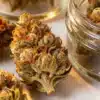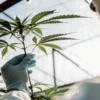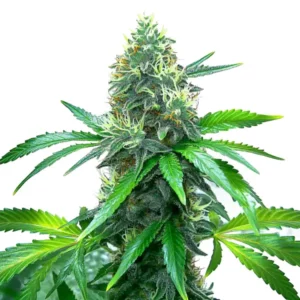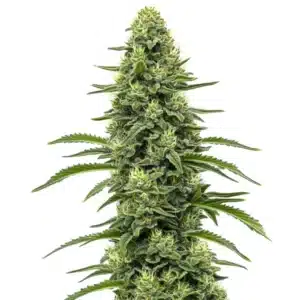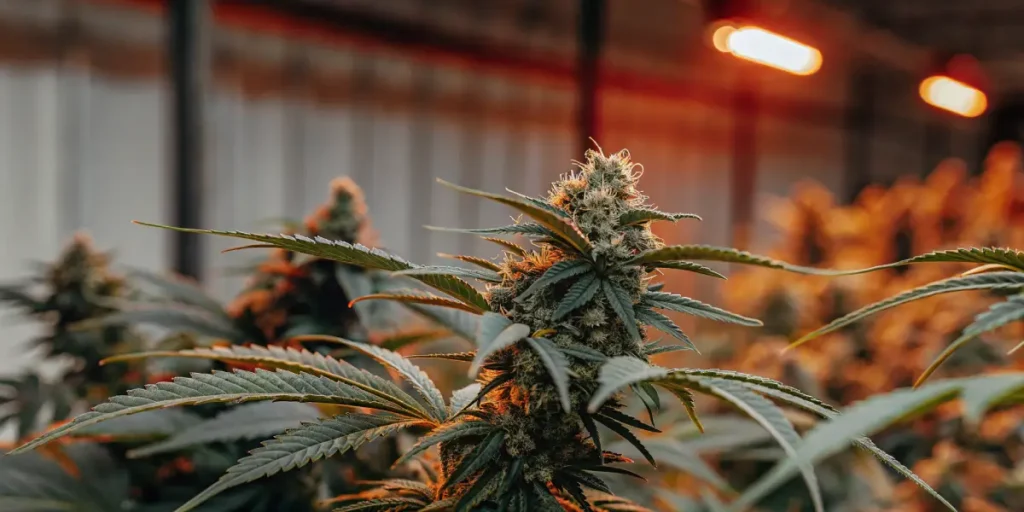
Strains That Respond Best to Far-Red Light
Cannabis growing has taken a scientific turn with the introduction of far-red light technology. This specific light spectrum can significantly influence the growth and yield of certain cannabis strains. By knowing which strains respond best to far-red light, growers can maximize their harvest and improve the quality of their crops.
Far-red light, typically defined as light with wavelengths between 700 and 780 nanometers, plays a crucial role in the growth cycles of many plants, including cannabis. It’s a part of the light spectrum that’s not visible to the naked eye but can impact plant development significantly. When cannabis strains are exposed to far-red light, they experience a process known as the “Emerson effect,” which can enhance photosynthesis and boost plant growth.
Recommended Strains
Purple Kush
|
|
THC | 17% - 27% (Medium) |
|
|
Type | Feminized |
|
|
Yield | Medium |
|
|
Phenotype | 30% Indica / 70% Sativa |
Girl Scout Cookies
|
|
THC | 18% - 25% (Medium) |
|
|
Type | Feminized |
|
|
Yield | High |
|
|
Phenotype | 60% Indica / 40% Sativa |
Choosing the right strains that respond best to far-red light can make a difference. Some strains have evolved to thrive under these conditions, leading to better yields and more robust plants. Let’s dive into some of the best cannabis strains from Blimburn Seeds that excel when exposed to far-red light.
Why Far-Red Light Matters for Cannabis Growth
Far-red light is often overlooked in traditional cannabis cultivation. However, its benefits are becoming increasingly recognized by both novice and experienced growers. This spectrum of light can influence a plant’s flowering time and overall growth health. By using far-red light, you can manipulate the plant’s natural processes to your advantage.
Plants exposed to far-red light can display enhanced photosynthetic efficiency. This means they can convert light energy into chemical energy more effectively, promoting faster growth rates and increased biomass. For growers, this translates to larger plants and potentially higher yields. By incorporating far-red light into your grow setup, you can create an environment where your plants thrive.
The cannabis strains far-red light response varies depending on their genetic makeup. Strains that naturally respond well to this spectrum tend to have optimized growth cycles, resulting in improved flowering and overall plant health. For growers, understanding these responses can be the key to unlocking a more productive grow operation.
Furthermore, far-red light can enhance the plant’s ability to absorb nutrients, leading to more vigorous growth. By integrating far-red light into your setup, you can ensure that your cannabis plants are not only growing faster but also developing stronger structural integrity, which is essential for supporting heavy buds and flowers.
Best Cannabis Strains for Far-Red Light Exposure
Some cannabis strains are naturally more receptive to far-red light, making them ideal for growers looking to optimize their harvest. These strains have adapted to absorb this spectrum of light efficiently, translating to better growth performance. At Blimburn Seeds, you can find several strains known for their responsiveness to far-red light.
One standout strain is Purple Kush. This strain is renowned for its ability to adapt to various lighting conditions, including far-red light. Growers often notice an increase in both the size and density of buds when Purple Kush is exposed to this light spectrum. Its resilience makes it a favorite among those looking to experiment with advanced lighting techniques.
Another excellent choice is Blue Dream. Known for its robustness and high yields, Blue Dream responds particularly well to far-red light. This strain can produce more substantial foliage and impressive flowers when grown under these conditions. Growers appreciate its reliability and the quality of buds it produces.
The best plant strains far-red light exposure can significantly influence include those with a genetic predisposition to thrive under such conditions. These strains not only deliver higher yields but also produce flowers with enhanced aroma and potency. By selecting strains that have shown a positive far-red light response, growers can maximize the potential of their cultivation efforts.
It’s important to note that the effectiveness of far-red light can vary between strains. Therefore, experimenting with different strains and observing their growth patterns can help growers fine-tune their lighting strategies. Such experimentation can lead to discovering new strains thriving under far-red light conditions, further expanding the possibilities in cannabis cultivation.
Promos & Deals
Maximizing Growth with Far-Red Light
To make the most out of far-red light, it’s essential to understand how to integrate it into your grow setup effectively. This involves selecting the strains that respond best to far-red light and ensuring your equipment is optimized for this part of the spectrum.
Using light-emitting diodes (LEDs) that provide far-red light can be beneficial. These LEDs can be incorporated into your existing lighting setup to enhance the spectrum available to your plants. It’s crucial to balance the amount of far-red light with other spectra to prevent unwanted stretching or other growth issues.
Knowing the optimal balance of far-red light in conjunction with other light spectra can help avoid potential pitfalls such as over-stretching. This balance is key to achieving the desired growth characteristics, ensuring that your plants develop strong stems and a robust structure capable of supporting heavy yields.
Moreover, by regularly monitoring the environmental conditions and adjusting the light exposure, growers can fine-tune the growth environment. This adaptability allows for the optimal strains growth under far-red light conditions, ensuring that each plant reaches its full potential in terms of size, yield, and quality.

Strains Thriving Under Far-Red Light Conditions
One of the strains that thrive under far-red light is Girl Scout Cookies. Known for its potent effects and delightful aroma, this strain can benefit significantly from far-red light exposure. Growers often report an increase in resin production and more vibrant colors in the buds.
When cultivating Girl Scout Cookies, providing a balanced light spectrum that includes far-red light can enhance its growth characteristics. This strain tends to produce dense buds with high THC content, making it a popular choice among enthusiasts.
Strains thriving under far-red light conditions often exhibit more vigorous growth and stronger resistance to environmental stresses. This adaptability can be crucial in maintaining healthy plants throughout the growing cycle, from seedling to harvest.
Furthermore, by choosing strains that are known for their far-red light responsiveness, growers can ensure a more consistent and reliable harvest. This predictability is especially valuable for those operating on a commercial scale, where maximizing efficiency and output is a priority.
Optimizing Your Grow Space for Far-Red Light
Integrating far-red light into your growing environment is not just about choosing the right strains. It’s also about setting up your grow space to maximize the benefits of this light spectrum. Start by selecting high-quality lighting equipment that can deliver the correct intensity of far-red light.
Consider using reflective materials in your grow space to ensure even distribution of light. This can help in maximizing the exposure of your plants to far-red light, ensuring each part of the plant receives adequate light for optimal growth. Regular monitoring and adjusting the light schedule can also contribute to better outcomes.
Ensuring that your grow space is optimized for far-red light includes paying attention to light intensity and duration. Striking the right balance can prevent issues such as photoinhibition, where too much light can actually slow down plant growth.
Additionally, maintaining proper environmental conditions such as temperature and humidity can enhance the effects of far-red light. By creating a holistic growing environment, growers can fully exploit the plant species far-red light benefits, resulting in healthier and more productive plants.
Plant Species and Far-Red Light Benefits
Not all plant species respond equally to far-red light, but cannabis is particularly well-suited for this light spectrum. The benefits include faster growth rates, improved photosynthetic activity, and enhanced flowering. By selecting strains that respond best to far-red light, you can leverage these advantages for a more successful grow.
Utilizing far-red light can also promote the development of secondary metabolites in cannabis plants. These compounds contribute to the plant’s aroma, flavor, and potency. For growers seeking to enhance the sensory qualities of their cannabis, integrating far-red light can be an effective strategy.
Knowing the specific needs of different plant species can aid in maximizing the benefits of far-red light. While cannabis responds particularly well, other species may also show improved growth patterns under this spectrum, making it a versatile tool in diverse horticultural applications.
Furthermore, the ability of far-red light to enhance the production of secondary metabolites can lead to more aromatic and flavorful products. This improvement in quality is a significant advantage for growers looking to differentiate their produce in a competitive market.

FAQs
What is far-red light, and how does it affect cannabis growth?
Far-red light is a part of the light spectrum with wavelengths between 700 and 780 nanometers. It’s invisible to the naked eye but plays a significant role in plant growth. In cannabis cultivation, far-red light can enhance photosynthesis and promote faster growth rates. This light spectrum can influence flowering times and improve overall yield, making it a valuable tool for growers.
When cannabis plants are exposed to far-red light, they can experience the Emerson effect, which boosts photosynthetic efficiency. This means plants can convert light energy into chemical energy more effectively, leading to more robust growth. Incorporating far-red light into your grow setup can significantly enhance plant development and yield potential.
The impact of far-red light on cannabis growth is profound, as it can alter the plant’s physiological processes. By promoting efficient energy conversion, far-red light helps in achieving rapid growth and development, which is essential for maximizing yield.
Moreover, understanding how far-red light interacts with other environmental factors can help growers tailor their cultivation practices. This knowledge allows for the creation of an optimized growing environment that leverages the full potential of strains that respond best to far-red light.
Which cannabis strains respond best to far-red light?
Certain cannabis strains have shown remarkable responsiveness to far-red light. Strains like Purple Kush, Blue Dream, and Girl Scout Cookies are known for thriving under far-red light conditions. These strains have adapted to absorb this light spectrum efficiently, resulting in enhanced growth performance and higher yields.
By selecting these strains from Blimburn Seeds, growers can take advantage of far-red light to boost plant health and yield. These strains are well-suited for both novice and experienced growers looking to optimize their cultivation with advanced lighting techniques.
Exploring the best plant strains far-red light exposure can reveal new opportunities for optimizing growth. Strains that have evolved to make the most of this light spectrum often display improved vigor and resilience, which are valuable traits in any cultivation scenario.
For growers looking to experiment with lighting setups, selecting cannabis strains with a known positive response to far-red light can provide a solid foundation. This approach minimizes risks and maximizes potential rewards, creating a more efficient and productive growing operation.
How can I integrate far-red light into my growing environment?
Integrating far-red light into your growing environment involves selecting the right lighting equipment and optimizing your grow space. Using LED lights that deliver far-red light is an effective way to provide this spectrum to your plants. Additionally, using reflective materials can help distribute light evenly, ensuring all parts of the plant receive adequate exposure.
Balancing far-red light with other spectra is crucial to prevent unwanted growth issues. Regular monitoring and adjustments to the light schedule can enhance plant performance. By creating a well-balanced lighting environment, growers can maximize the benefits of far-red light in their cannabis cultivation.
Incorporating far-red light effectively requires a strategic approach, ensuring that the light intensity and duration align with the plant’s growth stage. This precision can prevent potential issues such as light stress and facilitate optimal plant development.
By continuously evaluating the plant’s response to far-red light, growers can make informed adjustments to their setup. This iterative process allows for the fine-tuning of conditions, ensuring that strains thriving under far-red light receive the best possible care for maximum yield and quality.
What are the benefits of using far-red light in cannabis cultivation?
Using far-red light in cannabis cultivation offers several benefits, including enhanced photosynthetic activity, faster growth rates, and improved flowering. This light spectrum can increase biomass production and yield potential, making it a valuable addition to any grow setup.
Far-red light can also promote the development of secondary metabolites, enhancing the aroma, flavor, and potency of cannabis. For growers seeking to improve the sensory qualities of their cannabis, incorporating far-red light into their cultivation strategy can yield impressive results.
The ability of far-red light to stimulate plant growth and development is particularly beneficial for those looking to optimize their cultivation practices. By leveraging this light spectrum, growers can achieve faster turnaround times and higher crop outputs.
Additionally, the enhancement of secondary metabolite production can lead to a more refined and desirable end product. This improvement in quality is a key consideration for those aiming to produce premium cannabis with distinct sensory characteristics.
Can far-red light improve the quality of cannabis buds?
Yes, far-red light can significantly improve the quality of cannabis buds. By enhancing photosynthesis and promoting faster growth, far-red light can lead to larger, more resinous buds. This light spectrum can also improve the development of secondary metabolites, which contribute to the plant’s aroma, flavor, and potency.
Growers using far-red light often report more vibrant colors and increased resin production in their cannabis buds. By selecting strains that respond best to far-red light, such as those available at Blimburn Seeds, growers can enhance the quality and yield of their cannabis harvest.
Achieving superior bud quality with far-red light involves understanding the specific needs of each strain. By tailoring the light exposure to match the plant’s requirements, growers can maximize the potential for producing high-quality, aromatic, and potent buds.
Furthermore, the improved photosynthetic efficiency associated with far-red light exposure can lead to a more robust plant overall. This robustness translates to healthier plants that are better equipped to resist pests and diseases, further ensuring the quality of the final harvest.








